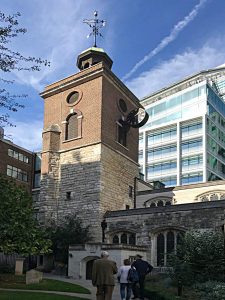For their annual outing, the ringers at Swaffham Bulbeck and Bottisham in Cambridgeshire traditionally drive around villages in rural areas, but this year was different. We decided to ring in some of the historic churches in the City of London, and I was ‘volunteered’ to do the organising.
To make the day interesting, I wanted to offer the ringers variety in both the size of the bells and the architecture of the churches. A walking tour seemed sensible, and the only feasible day of the week was a Saturday when the City would be quiet.

Arriving at St Olave’s
With help from fellow ringers, I put together a list of target churches and set about searching for contact details. This proved much more difficult and time-consuming than I expected; some people got back to me straight away and were extremely helpful, but others were not so accommodating, so I had to do a great deal of chasing. A lot of the churches I contacted were unavailable because they had already been booked out to other teams. It wasn’t easy to find five churches that were available at exactly the right times and within easy walking distance of each other, but I eventually managed to settle on a schedule which started and ended at Liverpool Street station.The final list comprised four rings of eight and one of six. I printed up a complete schedule for each of us –with maps, directions and photos as well as historical information about the churches and the bells. Here is the schedule in brief:
10.30 to 11.30 – Christ Church, Spitalfields (8) 17cwt. One of London’s most magnificent buildings, built in the early 18th century by Nicholas Hawksmoor.
12.00 to 13.00 – St Katharine Cree, Aldgate/ Leadenhall Street (6) 9cwt. Its unique Jacobean architecture dates from the 1630s. It survived the Great Fire and the Blitz. The organ was played by both Purcell and Handel.
13.15 to 14.15 – LUNCH: Windsor Fenchurch, 2 New London Street. Superb lunch and excellent service.Highly recommended.
14.15 to 15.15 – St Olave, Hart Street (8) 11cwt. A genuine medieval church which escaped the Great Fire, although it was severely damaged in the Blitz.Samuel Pepys and his wife are buried there.
15.45 to 16.45 – St James, Garlickhythe, Garlick Hill (8) ‘Jubilee Bells’ 9cwt. Built by Christopher Wren after the Great Fire. The eight ‘Royal Jubilee Bells’, cast at the Whitechapel Foundry, were first rung on a barge on the River Thames in 2012 and later installed in the church.
17:00 to 18:00 – St Lawrence Jewry, Guildhall Yard,Gresham Street (8) 24cwt. A grand building by Wren,badly damaged in the war and restored in the 1950s
We ended up with 19 ringers and three guests, which was about right. The youngest was 13 and the eldest was 80-something. Lunch took a lot of organising and reorganising, but when we arrived at the pub our meals were ready, so it paid off. At some churches we were welcomed by resident tower captains, and at others we had to find our own way in, although we had been briefed in great detail. A couple of us ran around collecting keys from various places and delivering them back again.
It was a nice surprise to bump into the Shenfield ringers at Garlickhythe, as well as some familiar faces at one or two other churches.The timings worked perfectly, the weather was glorious, and the ringing was great fun. We had good variety of bells to ring; those of us who are less experienced benefited greatly from this. The two heaviest rings – Spitalfields and St Lawrence Jewry – were particularly memorable.It was nice to walk around and enjoy the stunning architecture of the City of London when there weren’t many people around. Several of us repaired to a good hostelry before boarding the train home, which gave us a chance to reflect on a fascinating and enjoyable day
This article first appeared in the 10th edition of Tower Talk. If you would like to sign up to receive this free, quarterly e-newsletter for new ringers, please subscribe here

